Search the Site
The Problems in the Eventing World Today! (written in 2014) (Current freebie!)
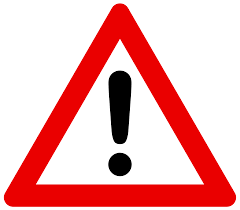
We have sadly arrived at a point in time where many of us read the latest Event recap with as much trepidation as curiosity. With so many horse and rider deaths happening in the sport, many are naturally calling for changes... But changes will only be effectual if we can identify the true cause of the problems!
First I do think we need to consider that the sheer number of starters in competition compared to back in the day, along with this being the age of instant information, might be making this problem appear more pronounced than it really is. I'm not denying there is a problem... it's just that those who bemoan the "good ole days" of the sport may not be being totally realistic.
If we compare the number of starters in an Event now vs 40 years ago, we would probably see that the ratio of falls to starters has not changed a whole lot. And back then, if a horse died on course, not many ever heard about it. I have been attending the Rolex 3 Day for almost 35 years, and I can say that it is a fact that there are almost always a number of bad falls every single year. One only has to watch some old Eventing videos to see how much carnage there was back then as well. Also let's not forget that due to great advances in veterinary medicine, horses are out there competing much harder and much longer than ever before.
It has always been a dangerous sport. And we will never be able to take the danger out of it completely. But of course we need to find a way to make it as safe as possible, for both horse and rider - while yet preserving the essence of the sport.
Rotational falls are obviously one of the biggest dangers, and something that we should do everything in our power to prevent. Rotational falls happen when horses get caught in a situation where they can't get one or both front legs out of the way of the front of the obstacle on the takeoff.
There is a very obvious solution to this problem in my eyes - something that we can do that would make the sport of Eventing immediately safer. And that is to do away with cross country fences that have truly vertical profiles. If all solid fences had a significantly rounded or rampy front profile, horses would be able to recover from a bad moment on cross country, without having a rotational fall.
I realize that the statistics the USEA just published showed that ascending oxers were actually the most likely to cause a fall. But that is probably largely due to the fact that they are the most common type of jump on cross country courses. And even ascending oxers can have an unforgiving, vertical face. Look at this ascending table: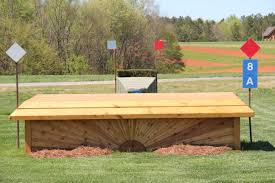
(Photo credit to LazerRayPhotos)
Or this ascending jump: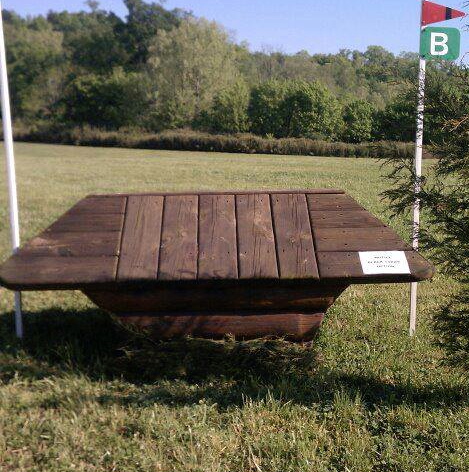
(Photo credit to LazerRayPhotos)
Both of these jumps show an ascending profile, yet still have a dangerous front face, that just begs a horse to catch a knee on the way up.
With the majority of jumps out there, the course designer tries to make the front profile forgiving by making the very top of the jump somewhat rounded. Here are some common examples: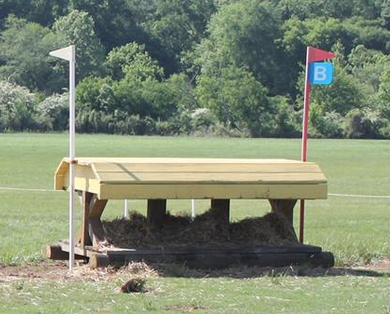
(Photo credit to LazerRayPhotos)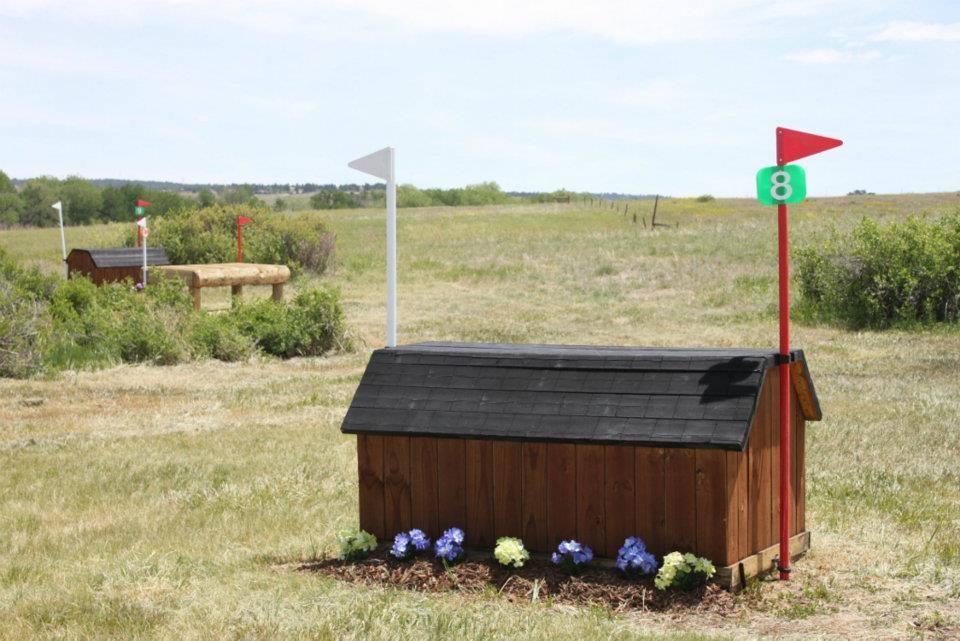
(Photo credit to LazerRayPhotos)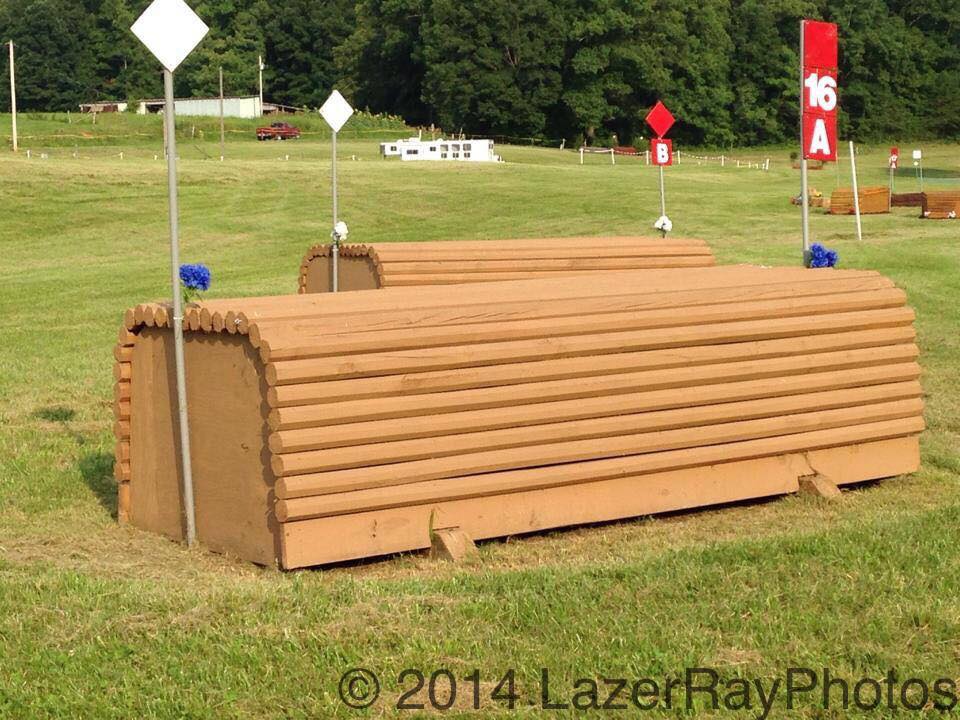
(Photo credit to LazerRayPhotos)
These fences still show quite an unforgiving profile, despite the slight rounding on top. A horse that makes a mistake, or is in less than perfect balance at the takeoff, can easily catch a leg and have a fall.
Look at this very common version of a table jump: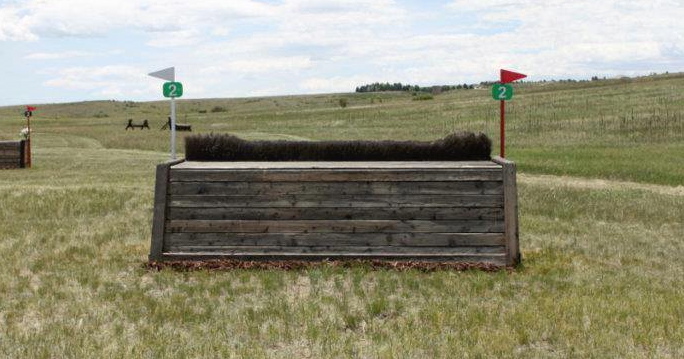
(Photo credit to LazerRayPhotos)
Technically it is ascending, as the back of the jump is higher than the front. Yet it the front face is very unforgiving. Meet this galloping fence wrong, and the risk is high. How could it be safer? Here is a more "old fashioned" table, with a rampy profile: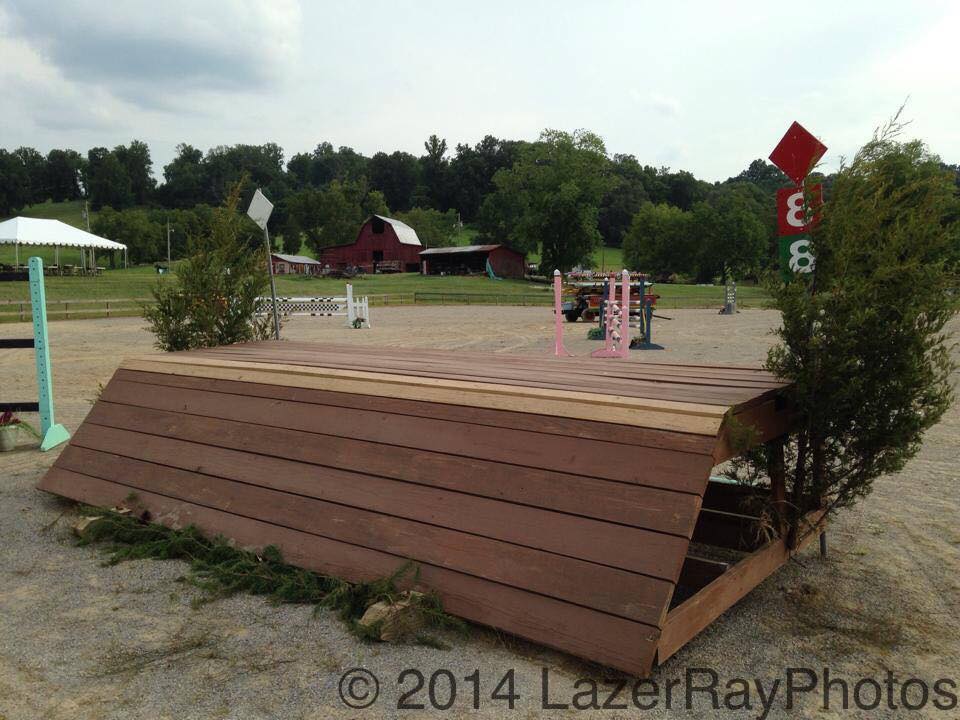
(Photo credit to LazerRayPhotos)
I call this an "old fashioned" type of table, because at one point in time (around the 80's and early 90's) many jumps were designed with this safety feature. Movement had been made at that time to make the more airy, flimsy, and vertical jumps of the previous decades more safe for horses to jump cleanly. Here is a jump from the 76 Olympics at Bromont, showing what many jumps were like in that time period: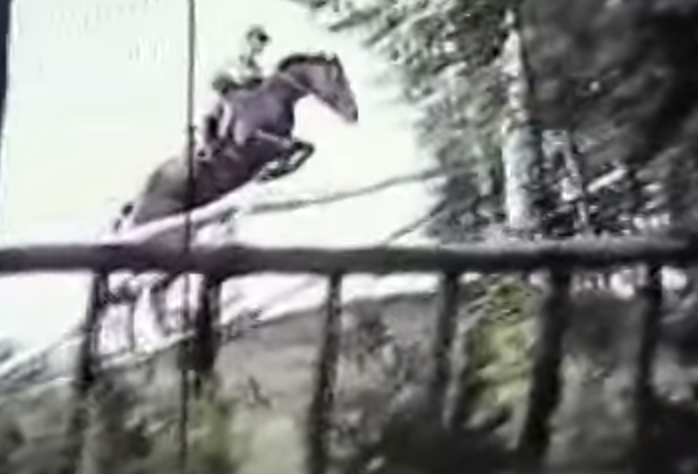
(Photo is a screenshot of a video)
So when they decided in the early 80's to make the jumps generally more solid, and shaped in a more forgiving manner, it was a good step in the right direction. Sure there were falls in that time period, but proportionally less rotational falls.
I'm not sure exactly how long that time period lasted, but at some point (I am guessing around the mid to late 90's) I started hearing talk of changing back to more vertical profiles. People were claiming that these forgiving fences were inviting bad and careless cross country riding... and that we needed to do something about that. So the trend unfortunately went back to putting vertical faces on the jumps... and rotational falls and deaths began to occur with more and more frequency.
I think this needs to be re-evaluated immediately. We already have the show jumping phase to test the horse and riders' ability to jump vertical faced fences cleanly. And there is always going to be some bad riding out there, unfortunately. Riders are always going to make mistakes. That will never change. We can't legislate good riding. We can try... but it will never work. Instead we have to create a situation on cross country where horses and riders will not be as severely punished for their mistakes.
The next biggest issue is course design in general. Around the same time that the vertical faces were coming back, it was decided that very skinny jumps should be added to more safely test the partnership of horse and rider on cross country. If the approach to the skinny jump was less than ideal, the result was more likely to be a runout than a fall. While this was a good idea, it may have been taken a bit too far.
Nowadays nearly every other jump on course at the upper levels is a skinny, a corner, or a sharp angle. And course designers love to further test horse and rider by constantly putting these types of fences in tight turning complexes. Which has turned the cross country into something much akin to a show jumping course out in a field. Since the speeds have not been adjusted to allow for all these turning complexes, horses and riders have to go ALL OUT in between complexes to make the time. It is much more tiring for the horse to have to make all these constant changes of speed. And there is also a mental fatigue that takes place when horses are asked the same questions over and over on course.
To make cross country courses more "horse friendly", each particular "question" should only be asked once or twice on any given course. One turning combination to the right, and one to the left is sufficient to test the partnership's ability to negotiate jumps on a turn. Much more than that can become punishing. One left corner and one right corner, a skinny or two, and maybe an angled line each direction would be sufficient to test the horse and riders' skills in those areas. Asking those same questions over and over after the horse has passed the first test is punishing, and leads to mental fatigue in the horse, which of course means slower reflexes. One only needs to sit and watch one of these complexes late on the course, to see the glazed look many horses have in their eyes at that point.
Courses should be designed with the "heart" of the horse in mind. This means that the courses should mentally build horses up, rather than tear them down. This is especially true at the middle levels of the sport, where the courses are supposed to be as much about "teaching" as they are about "testing." This means putting a straightforward galloping fence or two after every difficult question, to put heart back into the horse. And not putting the horse purposefully in a situation where he will be punished for making a big effort.
What do I mean by that? Take a look at this Preliminary bank complex from an event in 2011: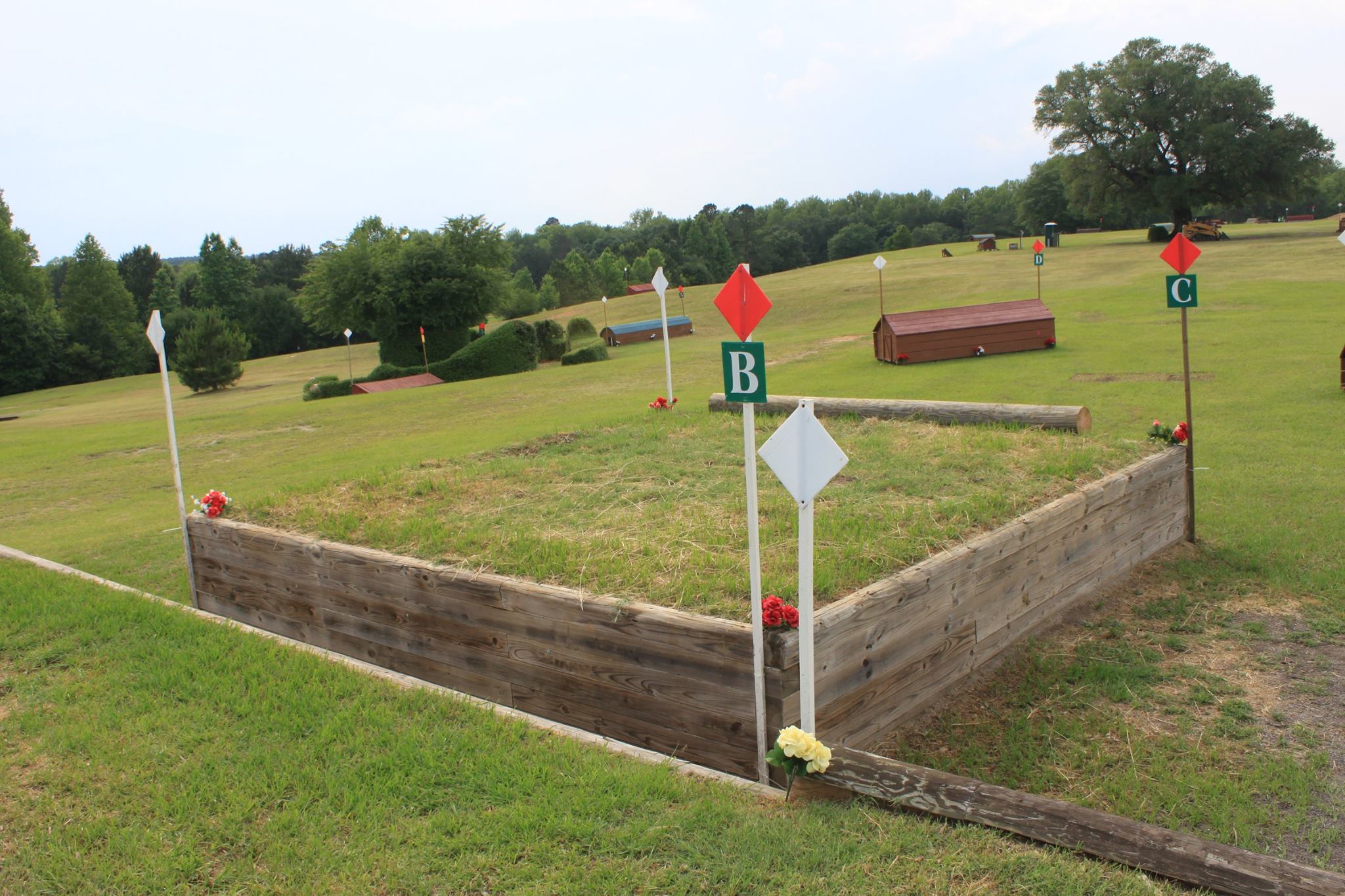
(Photo credit to LazerRayPhotos)
You don't see the "A" element here, which is the jump up the bank. The "B" element, being a ditch that connects the two banks, will invite a big jump. Between that and the striding to the "C" element, the horse will likely be making a big leap off of this bank. And because of that, the rider will probably then need to rip the horse's face off to make the tight left hand turn to the "D" element. What effect do you think that will have on the horse? Will the horse land from this complex eagerly looking for the next fence? Or will he be thinking, "Wow, I'm not sure I like this job..." at that moment?
It is much kinder to the horse to put a jump that doesn't invite a big leap with lots of momentum before any sharp turn. That way it can be done smoothly. Which will keep the horse liking his job, and therefore feeling confident about the next fence, whatever that may be. And a confident horse that likes his job will tend to think more forward and be more clearly focused at the jumps, which ultimately makes him safer.
This bank complex, by the way, was number 4 A,B,C,D on this Prelim course. And the next 2 fences were so challenging that only a handful of horse and rider combinations out of the 2 divisions of Preliminary got past jump number 6 on this particular course. I am willing to bet that if being forced to make that sharp turn after the drop hadn't put such a bad taste in the horse's mouths, many more horses would have been able to keep going around this course. A turn to challenge rider's control after a drop fence is fine, but a milder turn would have been more horse friendly, especially at this early stage on a Prelim course. Every effort should be made on the course designers part to try to make horses feel like they are the best cross country horses in the world when they cross that finish line.
The next point I want to bring up is that of training in such a way to keep the horse's natural initiative alive. The horse's ability to think for himself must be preserved in the training process. The more riders micromanage the horse's footwork and timing coming into jumps when training, the less the horse will be in the habit of doing any thinking about his own footwork. What this means is when the horse is trained practically to the point of "robot," where every footfall and takeoff spot is controlled and dictated 100% by the rider - the horse will be lost when his rider makes a mistake. Because his instincts to look after himself have been squelched in training, they will not be there when he needs them the most. So he is more likely to not make a good decision... or any decision at all at the takeoff - and therefore is more likely to fall.
And there is no way that training riders to be better about "finding a distance" is the answer to this problem. Because every single rider will make a mistake now and then - even the best of them. Horses have two eyes and a brain of their own, and they don't want to fall down. They can take care of their own footwork and timing just fine... but ONLY if we nurture that ability in training. The rider's job is to create the right canter for each situation, with the right amount of speed and impulsion for the fence in question, to be accurate on the line, and to then maintain the rhythm and balance all of the way to the jump - All of this while staying out of the horse's way enough to let him focus entirely on the jump in front of him.
There should be no doubt that a horse will jump his best when he can focus on each jump without distraction. If the rider has created the right canter, and the horse has been trained to think for himself, the horse will make good decisions when he is allowed to focus on the jump. As the old saying goes, "There is no better master of their own legs than the horse."
The type of horse currently out there competing also plays a part in the current state of the sport. Since everyone wants to get that "edge" in the Dressage ring, more and more warmblood blood is out there competing in the sport of Eventing at the top levels. Now, this isn't a problem in itself. Warmbloods are obviously very capable of doing all three phases of the sport. But when going back to my earlier point about modern course design, the physical and mental fatigue created by todays upper level courses takes even more of a toll on the non TB type horse, who is simply not bred for that kind of endurance. And it used to be that we chose our Event horses based on their ability to be bold, clever, athletic cross country machines. Today the horse's ability to win the Dressage phase is much higher up on the list.
So the horses are getting fancier... But are the riders truly adapting to the difference in the type of horse they are riding when they are out on cross country? Are they really getting their warmbloods as fit for a 3 or 4 star as the TBs were in years past? Are they taking into consideration the disadvantages of the more submissive nature of the type of horse that is bred for Dressage, and not bred specifically to run and jump for long distances at great speed? I'm not so sure...
And then there is the matter of over competing. In the days of the long format 3 Day Events, riders used to follow a strict conditioning schedule leading up to and peaking at the 3 Day Event that was at the end of each season. And after that 3 Day, most horses would get an extended period of rest and recuperation. They would then begin the process of gradually building back up and peaking at the next big 3 Day.
Ever since the death of the long format 3 Day Event at the upper levels, horse/rider combinations are out there competing every couple of weekends all year long. Here comes that mental fatigue again. The horses may look 100% fit and healthy, but there is a natural tendency towards becoming less focused, or a bit too casual mentally when performing the same tasks over and over. They will most certainly not be as fresh as the horse who builds a peak fitness level for a particular event once or twice a year.
And my final point is that the training for horse and rider should be done with the whole picture of the sport of Eventing in mind. Taking Dressage or Show Jumping lessons from specialists in those disciplines must be done very carefully, to avoid losing the essence of what makes an Event horse an Event horse. As long as they are well versed in working with Eventers, it can work. But riders should be careful about this concept in general. The Event horse's initiative must not be disturbed. And the Dressage and Show Jumping worlds do not generally strive to maintain that.
To sum up... the things I feel we should focus on or change immediately to make this sport safer are:
- Make fence profiles on cross country fences more forgiving. No more truly vertical faces... even on ascending oxers.
- Either slow the speeds for the upper levels to compensate for the twisty turny and overly technical courses, or keep the speed the same and make the courses more straightforward and galloping again. And I much prefer the latter.
- Ensure course design is truly striving for the goal of teaching and encouraging as much as it tests at the middle levels. The courses should build heart, instead of take it away from the horses.
- Even at the highest levels, the cross country courses should be able to test in such a way that they do not demean the horse's spirit... causing them to turn from a proud cross country machine into an obedient robot.
- Train in such a way to nurture the horse's natural sense of self preservation, and teach him to think confidently for himself out on cross country.






